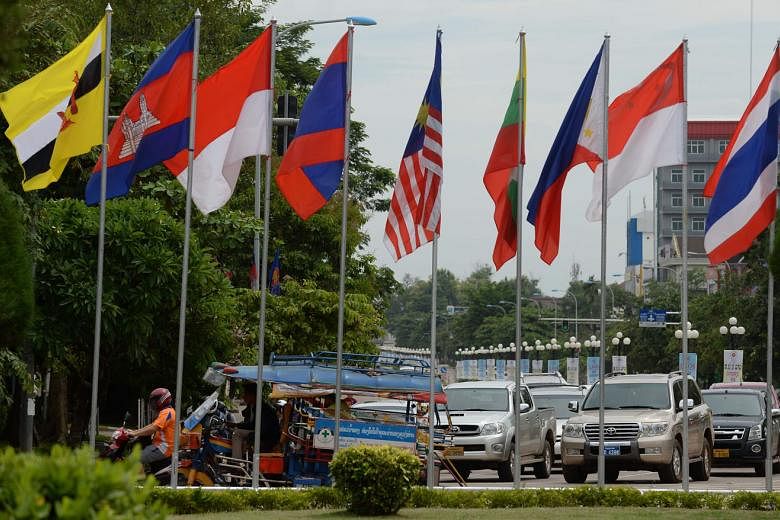With the South China Sea disputes and differences in opinion within Asean grabbing headlines recently, the 10 South-east Asian countries seem to have lost some of the goodwill built from their efforts on economic cooperation both within and outside the region. This should be a matter of concern for policymakers and related stakeholders.
Asean national governments need to step up their efforts in communicating the progress made under the regional economic integration exercise, especially as economic ministers meet this week in Vientiane, Laos.
The 10 governments need to reiterate the importance of the Asean Economic Community (AEC) for a better economic future in the region. They should increase discussion of economic cooperation at national levels.
This is because regional projects like the AEC put pressure on member governments to undertake domestic reforms and set national norms and regulations to international standards. For the private sector, the AEC is a reminder that socio-economic changes are inevitable and that firms should constantly look for innovative ways of production to remain cost-effective and competitive.
The AEC's promise to deliver on better economic growth and equitable development also enables the 10 Asean countries to develop consensus relatively easily, thereby showcasing their unity to international observers and building confidence among foreign investors. It reinforces Asean's centrality and helps member countries to integrate smoothly in the bigger geography of East Asia.
After completing its first phase of economic integration in late 2015, the AEC is moving to its next 10-year phase, paying further attention to activities of businesses and people. The new AEC 2025 continues with the AEC 2015 vision of a deeply integrated and cohesive region. It promises to deliver on equitable and inclusive economic growth in the future.
In addition to its focus on trade and investment initiatives both for multinational corporations and small and medium-sized enterprises, AEC 2025 emphasises the use of science and technology, development of human resource capability, good governance and connectivity.

These regional economic commitments point to the fact that despite several geopolitical issues, the AEC continues to remain an important undertaking for the South-east Asian nations. The common wish to remain competitive in order to attract foreign capital is convincing enough for Asean members to advance their economic cooperation.
Besides the AEC, the 10 South-east Asian countries are also involved in other regional economic projects. As a grouping, the 10 are leading negotiations of the Regional Comprehensive Economic Partnership (RCEP) agreement, and a subset of Asean members are part of the Trans-Pacific Partnership (TPP) pact led by the United States. The countries also support China-led regional infrastructure initiatives, namely the One Belt, One Road (OBOR) and the Asian Infrastructure Investment Bank (AIIB).
All these directly or indirectly promise smooth cross-border movement of people and goods and assure ease of doing business among the participating members. These regional cooperations, in general, are in line with South-east Asian countries' interest of following cooperative relationships and developing institutional frameworks with the bigger economies of the US, China, Japan, South Korea and India.
But most of these bigger regional projects have yet to come to fruition. While the RCEP is stuck in negotiation challenges, the TPP is hanging at the mercy of the US Congress. The AIIB has recently started approving loans, and details on OBOR are still unfolding.
As the other projects are still in their nascent stages, this is the time when Asean countries should put their own house of AEC in order.
After celebrating the success of eliminating border tariffs for intra-regional trade, the countries should comply with other qualitative regional commitments, such as eliminating domestic regulations that act as non-tariff barriers to trade, streamlining customs procedures, offering greater certainty with investment environment and many others.
This is the time when the countries should get buy-in from their people and businesses for economic integration, while elaborating to them the macro-level changes that the AEC or other regional integration initiatives may bring to participating members. The governments should lay down the pros and cons of economic integration to common people and explain the domestic safeguards put in place to avoid the adverse effects of economic integration.
While strengthening the AEC will give confidence to Asean member economies that they can work together for a common good, it will also highlight to an international audience that Asean cannot be discounted altogether because of a couple of unpleasant incidents over the maritime dispute.
Economic cooperation among the 10 South-east Asian nations has the potential to deliver on a more integrated and united Asean. Highlighting this will present a more balanced view of Asean to the domestic stakeholders and the rest of the world.
- The writer is Fellow and Lead Researcher (Economic Affairs) at the Asean Studies Centre of Iseas - Yusof Ishak Institute, Singapore.

